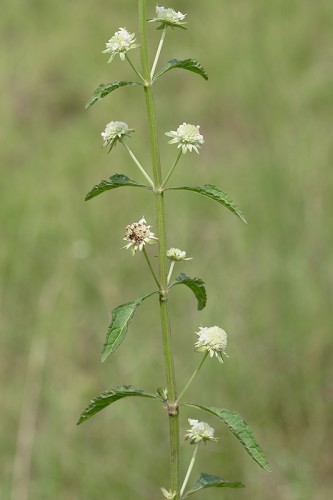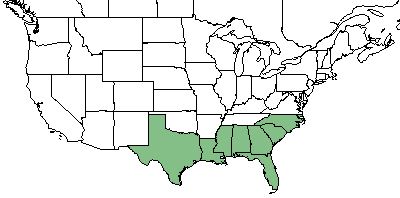Hyptis alata
Common names: clustered bushmint [1] , musky mint [2]
| Hyptis alata | |
|---|---|

| |
| Photo by the Southeastern Flora Plant Database | |
| Scientific classification | |
| Kingdom: | Plantae |
| Division: | Magnoliophyta - Flowering plants |
| Class: | Magnoliopsida - Dicots |
| Order: | Lamiales |
| Family: | Lamiaceae |
| Genus: | Hyptis |
| Species: | H. alata |
| Binomial name | |
| Hyptis alata Raf. | |

| |
| Natural range of Hyptis alata from USDA NRCS Plants Database. | |
Contents
Taxonomic Notes
Synonyms: H. radiata Willdenow
Description
H. alata is a perennial forb/herb of the Lamiaceae family that is native to North America.[1] It can grow up to 4 feet tall with round flower heads and individual flowers spotted with purple. Leaves simple, oppositely arranged, lanceolate, and with serrated leaf margins. As well, its common name comes from the musky mint odor the plant gives off.[3]
Distribution
H. alata is specifically found in Florida, Georgia, South Carolina, North Carolina, Alabama, Mississippi, Louisiana, and Texas in the southeastern United States. [1] It is also native to the West Indies.[4]
Ecology
Habitat
H. alata is commonly found in wet pine savannas, edges of swamp forests, and moist ditches.[4] Additionally, habitats that specimens of H. alata have been recovered from include pine flatwoods, in sandy peat of swampland, burned pineland, cypress dome, wet sandy loam, and coastal hammock. [5] It is listed by the USDA Natural Resources Conservation Service as an obligate wetland species that is almost exclusively found in wetland habitats.[1]
Phenology
Generally, H. alata flowers from late June until September.[4] It has been observed to flower in June, July, September, and October. [6]
Conservation and Management
Cultivation and restoration
Photo Gallery
References and notes
- ↑ 1.0 1.1 1.2 1.3 USDA Plant Database
- ↑ Kalmbacher, R. S., et al. (1994). "South Florida flatwoods range vegetation responses to season of deferment from grazing." Journal of Range Management 47(1): 43-47.
- ↑ [[1]] Lady Bird Johnson Wildflower Center. Accessed: May 30, 2019
- ↑ 4.0 4.1 4.2 Weakley, A. S. (2015). Flora of the Southern and Mid-Atlantic States. Chapel Hill, NC, University of North Carolina Herbarium.
- ↑ URL: http://herbarium.bio.fsu.edu. Last accessed: June 2018. Collectors: R.K. Godfrey, R. Kral, Samuel B. Jones, Jr., Karen MacClendon, Gary R. Knight, Loran C. Anderson. States and counties: Florida (Charlotte, Brevard, Calhoun, Jackson, Franklin), Mississippi (Lamar)
- ↑ Nelson, G. PanFlora: Plant data for the eastern United States with emphasis on the Southeastern Coastal Plains, Florida, and the Florida Panhandle. www.gilnelson.com/PanFlora/ Accessed: 22 MAY 2018